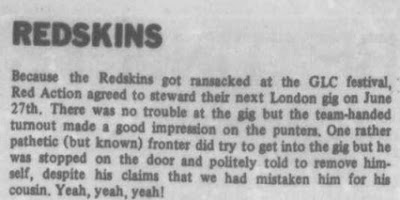56a Infoshop near the Elephant and Castle has been going for more than 30 years now as a small but perfectly formed radical social centre, bookshop and archive tucked in behind Fareshares Food Co-op at 56a Crampton Street, London SE17.
People have been invited to write a series of 'Annotated Archives' to highlight and reflect upon some of the huge amount of material crammed inside. The first series of these was launched in January 2023, but more are on their way.
In his contribution 56a lynchpin xChris highlights a few samples focusing on the labour, pain and love that goes into writing, printing and distributing: 'when you hold something from the archive in your hand, you are touching something that contains a labour of love from those who believed in it, producing it in various contexts and conditions and who, in thinking, in spreading the word virus, in getting it out, they believed it was part of changing the world!'
'Women's Squatting Histories and where to find them in the 56a Archive' does just what it says on the tin, pleased to see some of the zines produced by friends in the 1990s such as Shocking Pink, Feminaxe and Bad Attitude getting their dues.
With so much to choose from 'R-Z' looks at a 'tiny selection of the zines in the 56a Zine Library' from between those letters
'Here 2 There EP', Adam Denton's contribution, is less a guide to parts of the archive than a reflection on the possibilities and limitations of archive documents to access the past, in the specific context of his interest in the scene around 1990s techno/speedcore club Dead by Dawn held at 56a's sometime Brixton sibling, the 121 Centre on Railton Road. I went there a lot and have
written about it here so was of course interested in his take.
'We can still talk with the living here and the dead. We can read the blogs. We can think about how noise was characterised then and what's the use? what do you draw using noise now?, in the up-ticking criminalised sphere of just being about and trying to occasionally sleep.
'What we're most engaged with now and what we'll try to retain focus on, is the repercussions of noisey activity like DbD: how it came to be, what traces the tracks, themselves traces… If we take from the papers alone, it's difficult to know anything other than what we want to. There's some detailing of what goes on, we get a sense. But the reality of that lived time cannot be accessed, people may say, say many things, many misremembered, obscured or clarified by drug haze or….
After leaving hours earlier I eventually arrive home, sit for a while at the kitchen table, beginning to read again. Beginning Sadie Plant on Situationism again. […] I type SP as she gave a lecture at DbD at the 121 Centre according to the History is Made at Night blog, and I imagine her touching on it, on it somewhere. Dancing together in 93 is seeing me too glassy about other people's pasts’
‘communing at high BPM, pummelling and relentless music. I'm listening to some of that stuff as I write this, on the Praxis imprint. Wonder if it was about the kinds of people who were populating these nights: who was known, who was up for speaking before, what dissonance and breakage that kind of speech act engenders, in that context 1993 – what could happened here tonight? Spoken texts, becoming noise, cracks the buildings of amplified continuum. Was it friendship alone, shared purpose, the re-purposing where you went somewhere’

[my memory may be fallible but yes I saw Sadie Plant speak at Dead by Dawn in July 1995. According to the flyer she spoke on 'girls, music and other dangerous substances' if I recall correctly talking about some of the stuff that went into her book 'writing on drugs'. It was part of a night themed around 'cyber feminisms, grrrl DJs and she-core'. Most people turned up at the club much later, I think there was probably about 20 people max at the talk. I think I went from the talk to
Club UK (then back to 121) so was dressed for a glam clubbing night out in a silver Daniel James top and tartan trousers!]
 |
| Post lockdown party at 56a in July 2021 to celebrate its 30th birthday |
The next set of Annotated Archives will be launched at 56a on Thursday 27th April, 6-8pm. I've written one of them so come along for a chat, nibble stuff & grab free zines















































